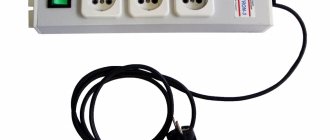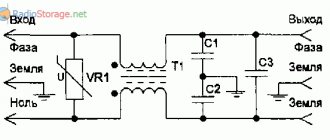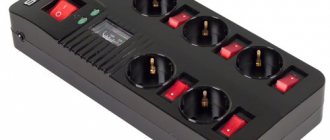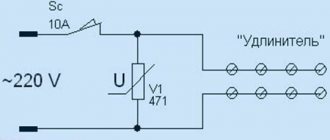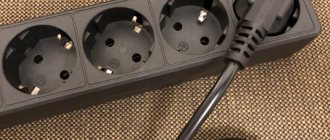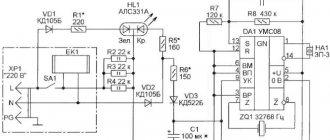Can it be repaired?
Depending on the cause of the breakdown, surge protectors are quite suitable for repair; the main thing is to have at least a little experience working with a soldering iron and a screwdriver. Before you begin, carefully inspect the outside of the appliance. Sometimes, to fix it, you don’t even have to disassemble it - it will be enough to replace a burnt or broken plug. When there are no external signs of failure, but when under load it makes strange sounds, then most likely it is the chokes (pulse voltage absorbers in the form of a coil) cracking.
When you need to change the fuse, this is also not a problem.
If the button does not work when turned on, the backlight does not light up, it is also not necessary to solder it right away - you can simply pull the switch body out of the socket, clean the contacts and carefully put it back in place
The button does not turn off
If the fuse is blown, then the button (the one without an LED, separate from the “on/off”) stops pressing and constantly sticks up, which means emergency mode without electricity supply. It is enough to unsolder it or unscrew it (depending on the model) to take it to a radio parts store, where the seller will pick up exactly the same one. It happens that the model you need is not on sale - no problem, you can connect the wires directly with your own hands without buttons. Then, instead of a surge protector, you will have an excellent extension cord, which will be quite useful for charging low-voltage devices, lamps and radios.
The light is flashing
The power switch button may turn off spontaneously or become completely stuck in the “on” position. Sometimes the power indicator starts blinking for some unknown reason. This also indicates that it is most likely time to clean the contacts. After disassembling the case, you need to remove everything that covers the button, unscrew the screws from the printed circuit board (to turn it over) or unsolder the power cable and button legs. After this, you can pull out the switch box and use a flat-head screwdriver to unhook the latches that hold it in the socket.
Inside there are contacts made of springy steel. Over time, they become covered with a layer of soot and oxide, so the contact area begins to heat up more than usual. If you clean them with sandpaper or a file, the button will no longer overload and turn off. At the end, you can treat the stripped areas with alcohol and blow them out, and then assemble the switch and solder it back.
Sparks
If the surge protector sparks when turned on, this indicates, rather, that the insulation of the internal contacts has been damaged, rather than that some part has broken. Look inside, check and, if necessary, use a tester to call where the wires might have come loose. If found, take more solder, because cheap Chinese factories often suffer from indecently flimsy soldering quality and savings on literally everything, including tin.
Keep in mind that sparking and cracking can occur not only due to a defect in the surge protector, but also due to a weak socket that is not designed for heavy loads. To check, find a good outlet or disassemble an existing one (after de-energizing it) to look for problems with the twists in the reconnaissance boxes (especially for Soviet aluminum ones).
Other breakdowns
Mechanical damage to the switch latches due to breakage and melting of the plastic is also possible. In this case, a hole is carefully drilled in the button body and a cotton swab or toothpick is inserted, acting as a latch that is inserted into the groove. After these simple manipulations, you can return the switch to its place. The surge protector is ready for use again!
If there is no voltage, then look for the section mark on it and buy a replacement of the required length. Next, you should disassemble the plug and body and solder the wires to the contacts, not forgetting to first properly clean and insulate them after soldering.
Surge filter for automatic washing machine. How to connect and what is it for?
The current washing machine is so modified and designed that many have already forgotten about the times when they washed several batches of laundry in the same water.
A modern washing machine is good in everything, and thanks to it, washing turns into a holiday, unless surprises occur in terms of malfunctions and breakdowns.
The machine will not be able to work without electricity, but there is a certain danger in this.
Unfortunately, power surges often occur in the network and can damage equipment. Such power fluctuations can lead to repairs to the washing machine.
Purpose of a surge protector
To eliminate the possibility of equipment breakdown due to power surges, you can protect your equipment in advance.
Main malfunctions and their causes
In working condition, the power cord must protect the connected devices from power surges; for this purpose, a fuse is built into it.
But sometimes problems arise that become noticeable only during operation. All reasons can be divided into two points:
- violation of the physical integrity of external parts (cable, button, sockets or plug);
- combustion of the insides of the block (tracks on the printed circuit board, automatic thermal fuse, switch contacts).
If the extension cord begins to malfunction, as evidenced by an uncharacteristic crackling sound, sparking or blinking of the LED, it must be immediately replaced or disassembled.
It is strictly not recommended to use a broken filter, because the very first power surge can burn out all the expensive equipment that is connected to it.
The device is a plastic case with sockets (sockets) for Euro plugs extending outwards. Contact plates sometimes become deformed if they are made of low-quality cheap metal, which leads to backlash and signal interruptions. In addition, the plug itself heats up, which often leads to its burnout, the plastic may melt and even a short circuit and fire may occur.
Repair - what to do if the surge protector button is broken
If, when you turn on the surge protector button, extraneous sounds begin to be heard, which are accompanied by the smell of melting plastic, the device should be immediately de-energized. Next, you need to disassemble the surge protector and check the condition of the contacts on the switch.
To do this you will need the following tools:
- soldering iron,
- crosshead screwdriver,
- tester,
- sandpaper-zero.
If the contacts are burnt out, the tester readings will confirm this (in this case, there will be no voltage at the output from the button in the “On” position). To clean the contacts, the switch needs:
- Disassemble the surge protector housing by unscrewing the mounting screws;
- Unsolder the button and remove it from the filter housing. The button is held in the housing by plastic clips, which should be carefully squeezed out.
- Disassemble. To do this, you need to disconnect the key by picking it up with a flat-head screwdriver.
- Take out the contacts and clean off any black deposits.
- Assemble the button. After this, we assemble the button in the reverse order, install it in place and solder it.
If the contacts have burned very badly and melted the plastic of the switch housing, it should be completely replaced.
To do this you need:
- Disassemble the filter;
- Unsolder the button;
- Remove the switch from the housing;
- Install a new one in its place (sold in radio parts stores, costs about 30 rubles);
- Solder the button and assemble the filter housing.
Often the button on the surge protector does not work due to mechanical damage. The most common case is the breakdown of the latches that hold the switch key in the housing. In this case, it is not necessary to buy a new button - the latches can be restored.
To do this you will need the following materials and tools:
- screwdriver (or drill) and drill with a diameter of 3.5 mm;
- toothpick;
- cotton swab;
- side cutters.
The process itself is very simple:
- A through hole is drilled in the key into which a cotton swab is inserted (it will act as a latch).
- A toothpick is inserted inside the cotton swab for greater rigidity. On both sides, the improvised retainer is trimmed with side cutters so that on each side it protrudes approximately 3-4 mm.
- Now all that remains is to insert the key into the body - to do this, just slightly bend the sides of the seat with a screwdriver.
VIDEO INSTRUCTION
How to replace a fuse in a surge protector
Smart TVs, refrigerators, computers, laptops, gas boilers - all this is expensive. Unfortunately, in a huge number of houses and apartments, the electrical network does not provide the appropriate voltage level. Overloads occur due to welding work nearby. Sometimes the zero contact on the access distribution box burns out, and 380V phase-to-phase voltage passes through the apartments. A surge protector quite successfully protects expensive household appliances, but you need to choose such a device carefully.
Marketers' deceptions
Everyone is familiar with multi-outlet power strips offered by many manufacturers. Their price is attractive. Marketers call this extremely inexpensive device a surge protector and claim that the device will protect the equipment from all possible troubles.
It is easy to buy a multi-socket extension cord with protection for a washing machine, for a refrigerator, for a computer. There are devices of different levels: basic, standard, advanced. But in any case, the characteristics of such a device do not suggest that it can effectively protect connected equipment. In practice, everything works as follows.
- Basic class models have only a single-pin switch, as well as a neon and a reusable fuse.
- Devices of a standard class - with a reusable fuse, a non-fuse and a two-pin switch in good models. The latter interrupts both conductors, phase and neutral, to ensure that the power supply to the connected device is interrupted.
- Advanced models have an interference suppression capacitor, a fuse and a switch in the circuit.
Without exception, these so-called extension cords with RCDs cannot be guaranteed to protect equipment in emergency situations . For example, a reusable fuse limits the maximum current, but operates slowly enough to prevent damage to the connected device. A capacitor only copes with certain types of voltage surges. The purpose of such devices is only one: to limit the power consumption of a group of connected devices.
Important! Therefore, for a computer and for high-end household appliances, you need to buy a special electrical filter, the circuits of which are designed not only with protection against voltage surges, but are also capable of damping almost all types of harmonic interference.
What to choose?
The answer to the question depends on: a) the quality of the alternating current in your home; b) a specific consumer. If you firmly know that your voltage always stays around the norm of 220-230 V, then a surge protector is enough to protect any consumer.
Unfortunately, stability in Russian networks is more a rarity than a rule. Use a multimeter and see for yourself. It is unlikely that you will always observe normal voltage, especially somewhere in the countryside.
However, you should not immediately run for a stabilizer: not all equipment today requires a stable value of 220 V. Heating devices with heating elements, as well as short-term use devices with high starting currents (for example, pumps, power tools) definitely do not need it.
Most modern electronics are equipped with switching power supplies that can operate over a wide range: from 90 to 260 V and even more. The circuitry of such power supplies always produces a constant, stable voltage for the internal elements of the circuit. All computers are powered by such power supplies, therefore, contrary to popular belief, a stabilizer is not needed for a computer. Of course, a lot here depends on the cost and class of the computer power supply: cheap models may have a narrower range or simply work poorly even with small deviations.
TVs, monitors, computer system units, LED lamps and luminaires, chargers for laptops, tablets, phones and other household appliances, which include switching power supplies, almost never need voltage stabilizers.
What devices really need this unit? First of all, these are long-term use devices without built-in power supplies, in particular those based on electric motors: refrigerators, pumping stations, air conditioners, etc. When the voltage increases, these devices begin to work with overload, heat up more, and wear out faster.
Some models of gas boilers are especially sensitive to voltage drops. But not all! Therefore, before buying a stabilizer for a gas boiler, look at the instructions for the boiler.
If the documentation indicates a narrow operating range of input voltages (±5...10% of the nominal value), and the voltage in the outlet jumps much more, then, alas, you cannot do without a stabilizer.
You can learn more about whether a gas boiler needs a stabilizer or not from this article. And here they will tell you why your TV doesn’t need a stabilizer at all.
If you still use incandescent lamps and are annoyed by their blinking during power surges, then they can also be connected through a stabilizer. For this particular case, I highly recommend inverter-type stabilizers (for example, InStab from Shtil).
Finally, if any device (even an LCD TV or PC with switching power supplies) periodically turns off when the voltage drops, it still needs a stabilizer.
How protection works
A surge protector device necessarily includes several key blocks.
Source: https://favourite-svet.ru/elektroprovodka/neispravnosti-setevogo-filtra.html
Recommendations
If you have already decided to disassemble the filter, then at the same time check all other components for serviceability. Quite often, it is not fuses and buttons that fail, but a varistor, which is also needed to protect outgoing lines from high voltage.
Many people do not know the rules for operating network filters and connect them to uninterruptible power supplies, which leads to breakdown of the protective circuits. Also, you cannot connect the filters to each other, because a series connection will multiply the current in the ground phase, and the voltage power will increase above 3.5 kW. This applies specifically to devices with filters, and not just extension cords with a power button.
In addition, it is very undesirable to connect devices with high input voltage to simple models - not only will this not save them from burning out, but it will also quickly damage the filter itself.
How to repair a surge protector, see below.
No tags for this post.
Why do network filters fail?
The two main reasons why a fuse in a surge protector can fail are overload and overvoltage.
Surge filters are designed to protect office equipment from various types of fluctuations in the electrical network, and therefore you should not include high-power devices in them. In a faulty fuse, either the click is not heard when switching, or the button does not move at all. The following option is also possible: when the surge protector is plugged into the socket, a short circuit occurs due to a tripped disposable varistor installed parallel to the load contacts. It is not difficult to repair a surge protector; it is much more difficult to find the necessary components. For expensive filters, they are sold separately, but in the case of cheap ones, you will have to look for another faulty network adapter and remove the fuse from it.
